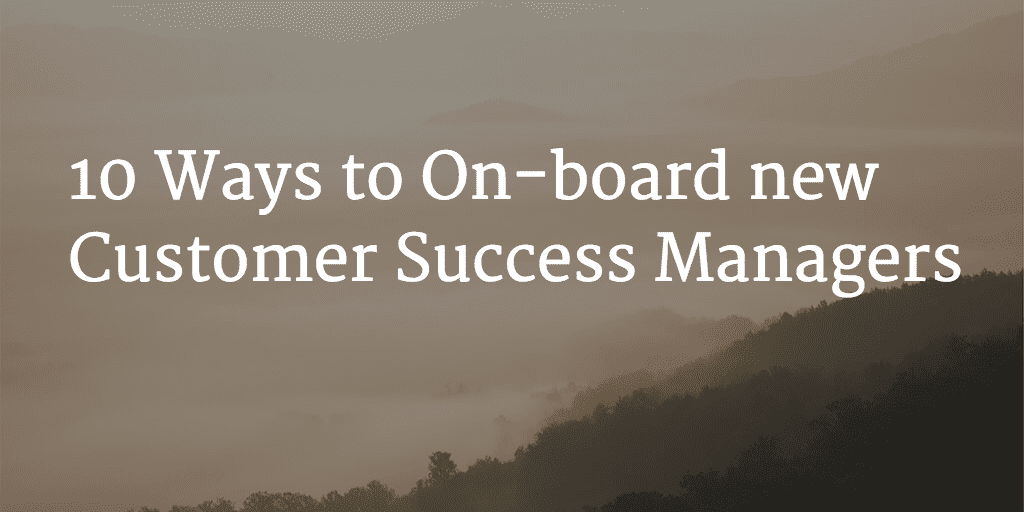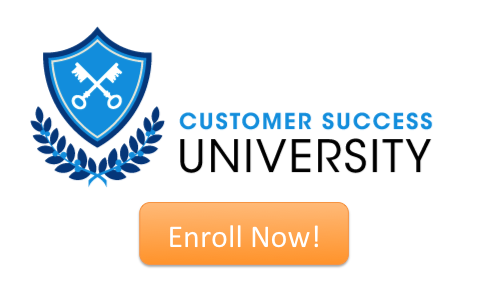Just like any job, it’s important to quickly and efficiently get Customer Success Managers (CSM) up and running.
Subscription Economy companies like yours spend a lot of money to acquire customers, so keeping them delighted, renewing, and wanting to buy more is absolutely critical to long-term success, which is where the CSMs come into play.
But rather than tackle the actual day-to-day activities a CSM will take on, or the things specific to your company (systems they’ll use, procedures they’ll follow, etc.), because I couldn’t address that anyway since it’s particular to your company, I want to talk about the things that aren’t usually part of an official on-boarding checklist.
How can we ensure our CSMs hit the ground running? Here are 10 things that should dramatically help with that process.
1. Help them take advantage of their newness – The good news is that when a CSM is new to an organization any questions are (or should be) fair game. They come to the team with the freshest set of eyes on everything. Use that “new-ness” to both of your advantage! Invite them to ask every question they can think of. You’ll be surprised at how often the answer is “I’m not sure why we do it that way” or “I never thought of that,” immediately exposing the team to new ideas or, more often, getting the team to finally look at why they do what they do.
2. Their knowledge bucket is empty – The great thing about a new hire is that they basically know next-to-nothing (in the context of their new position at a new company, obviously) at this point. This can be great because of the opportunities to learn. However, that empty bucket feeling can also be a point of frustration for a new CSM if it’s not addressed adequately. Understanding that, and really reminding them that everyone goes through a similar ramp up period and that there’s no point in beating themselves up is critical. As with any new hire on-boarding experience, identifying priorities and setting short-term goals are very important to keeping your sanity.
3. First. Impressions. Matter. – If they think the interview process is the hard part, remind them to think again. In a way that doesn’t put too much pressure, it’s never a bad idea to remind folks that you never get a second chance to make a good first impression. And the number of ‘first impression encounters’ is off the charts when you start a new job.
4. Naturally Curious at First – You hired your CSM for a reason; not just to fill a vacant position but because of something in them. You saw that they’re passionate customer success, have a natural curiosity and have a deep desire to learn… take advantage of this, especially in the early days. Do what you can to make these qualities their best friends in the first few weeks. Get them to enter each day with all three of those arrows in their quiver at first, because these “best friends” will be invaluable to them every step of the way. You want them to approach every new customer, and every new product feature with that same passion, curiosity, and desire to learn and it’s up to you to cultivate a culture that encourages that.
5. Put the FUN in Fundamentals – The responsibilities of a CSM can vary pretty widely, but the fundamentals are usually the same. They’ll need to understand your company’s value proposition, learn the product, develop some domain expertise, and enhance their customer relationship skills. That sounds like a lot, because it is. But don’t let them be daunted. The first few weeks of any new job are always the hardest, but done correctly, they can be the most rewarding, and ensuring these fundamentals are put in place and strengthened early on will lead to more successful CSMs- and therefore customers – in the long-run.
6. No one is on an island – Even if they work remotely… from an actual island, the CSM’s peers are a great resource for compressing their learning curve. It can be lonely in a crowd, and the type of networking or celebrating a new hire that you’d like to occur organically doesn’t always happen. So you need to facilitate methods to get your new CSMs to know the people in the organization, their responsibilities, and what they expect from you. From having them study the org structure and the job descriptions of others, to listening to sales calls and other CSM calls with their customers, there are many opportunities to get to know their peers and the work they do. Have them shadow an implementation, talk to the product team about open issues and feature requests, learn how marketing expects to interact with customers to create great success stories, etc. The bottom line is, if new employee boot camp isn’t offered, create your own for them because it’s worth the investment in time!
7. Take the “people” part to a deeper level – It’s important to ensure new CSMs know not only roles & responsibilities of their peers, but also the key processes and handoffs within the organization. Another important objective is to make sure they know how they’re going to be measured and how that fits with the overall company goals. Invite them to make suggestions around renewal goals, upsell opportunities, better survey results, and improvements in overall health of a customer. We’re all motivated through goals and those goals typically drive behavior so validating objectives can help bring clarity to most situations.
8. Demo to Learn – Obviously, they’re going to learn the product on their own by clicking around, absorbing training materials, and through other people in the organization. But if the product is complex, you need to make a concerted effort to stage learning into reasonable chunks. One way to get them started is by having them master a product demo to learn the value prop and lingo, which may represent knowledge at the 10K foot level. Then have them move down to the 1K foot level by mastering product training, for example. Finally, have them focus on the details of the implementation or onboarding process that will ensure that you’re becoming a true product expert. If the product is not very complex, you may want to reverse the order and start with the implementation!
9. The best way to learn a product is by using it – This doesn’t apply across the board, but wherever possible, the best way to really know the product is to use it, even if it’s not necessary to do your job. Nothing resonates with customers like talking to someone who actually uses the product. It allows you to truly speak their language. And being a user of your product advances your training beyond the academic level and into real life, which is exactly where your customers live. So, if possible, ensure your new CSM has access to the product and, even if contrived (make up a project for them to complete), a reason to use the product.
10. Get to know the Customers – Finally, as they’re learning the product, the people, and the process, they must also be learning about your customers. This is where your CSM will have some of your most important “first impression encounters” of all. Remind your CSM that if they’re thrown in to a customer situation early on that they don’t know how to handle, to always fall back on the basics: start meetings on time, have a thoughtful agenda, be organized on behalf of the customer, summarize meetings and conversations succinctly by documenting action items, owners, and due dates. It’s amazing how these small things can go a long way to building credibility and demonstrating your commitment.
There you have it… 10 ways to ensure your new Customer Success Managers are on-boarded properly.
Another way to ensure your Customer Success Managers have a super-solid base of understanding, enroll them in Customer Success University now.


